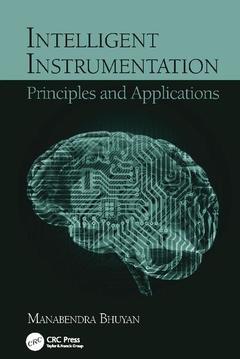Description
Intelligent Instrumentation
Principles and Applications
Author: Bhuyan Manabendra
Language: English
Subjects for Intelligent Instrumentation:
Keywords
Radio Isotope; RLC Circuit; Background of Instrumentation; Moisture Content; Sensor Performance Characteristics; Olfactory Receptor Neuron; Signals and System Dynamics; ECG Signal; Linearization; Calibration; and Compensation; Electronic Data Sheet; Intelligent Sensors; PLS; TEDS; IFR; Tv Control; Data Sets; CV CV; Transducer Interface Module; Collector Current; Laboratory pH Meter; Base Emitter Voltage vBE; Medium Μm; Smart Sensor; Variable Inductance Transducers; Laplace Transform; NCAP; Dummy Sensor; Intelligent Instrumentation; Temperature Interference; Ftp Server
Publication date: 06-2017
· 15.6x23.4 cm · Paperback
Publication date: 11-2010
548 p. · 15.6x23.4 cm · Hardback
Description
/li>Contents
/li>Readership
/li>Biography
/li>
With the advent of microprocessors and digital-processing technologies as catalyst, classical sensors capable of simple signal conditioning operations have evolved rapidly to take on higher and more specialized functions including validation, compensation, and classification. This new category of sensor expands the scope of incorporating intelligence into instrumentation systems, yet with such rapid changes, there has developed no universal standard for design, definition, or requirement with which to unify intelligent instrumentation.
Explaining the underlying design methodologies of intelligent instrumentation, Intelligent Instrumentation: Principles and Applicationsprovides a comprehensive and authoritative resource on the scientific foundations from which to coordinate and advance the field. Employing a textbook-like language, this book translates methodologies to more than 80 numerical examples, and provides applications in 14 case studies for a complete and working understanding of the material.
Beginning with a brief introduction to the basic concepts of process, process parameters, sensors and transducers, and classification of transducers, the book describes the performance characteristics of instrumentation and measurement systems and discusses static and dynamic characteristics, various types of sensor signals, and the concepts of signal representations, various transforms, and their operations in both static and dynamic conditions. It describes smart sensors, cogent sensors, soft sensors, self-validating sensors, VLSI sensors, temperature-compensating sensors, microcontrollers and ANN-based sensors, and indirect measurement sensors.
The author examines intelligent sensor signal conditioning such as calibration, linearization, and compensation, along with a wide variety of calibration and linearization techniques using circuits, analog-to-digital converters (ADCs), microcontrollers, ANNs, and software. The final chapters highlight ANN techniques for pattern classification, recognition, prognostic diagnosis, fault detection, linearization, and calibration as well as important interfacing protocols in the wireless networking platform.
Background of Instrumentation. Sensor Performance Characteristics. Signals and System Dynamics. Intelligent Sensors. Linearization, Calibration, and Compensation. Sensors with Artificial Intelligence. Intelligent Sensor Standards and Protocols. Questions. Index




